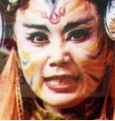| |
 |
Taiwanese
Opera has a history of more than a century. The primitive
“Lo-deh Sao”(落地掃)play has already evolved into delicate
and refined performance on modern stages. Besides the advancement
of modern technology, the development of Taiwanese Opera has
been profoundly influenced by the political and economic change
in Taiwan. Taiwanese Opera was born in Qing Dynasty, began
to flourish during Japanese Occupation, and faded for some
time after World War II. Because of the rise of the awareness
of local cultures here in Taiwan recently, Taiwanese Opera
has come to another transitional phase. |
 The “Indoor” Performance Period
The “Indoor” Performance Period |
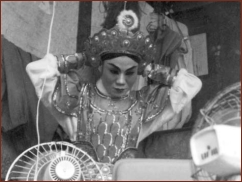 Around 1910, the primitive forms
of Taiwanese Opera, like Lo-deh Sao”(落地掃)or parade performances,
became popular. Some people came out to reform the performance
to make Taiwanese Opera more sophisticated. Gradually, Taiwanese
Opera was transformed from buffoon plays with bulk plots into
“Large Dramas” with complete plots. It’s called “the Old
Taiwanese Opera, or “the local Taiwanese Opera.” In the
beginning, while the performance of Taiwanese Opera remained
primitive and still played on “Outdoor Stages”, it has already
taken the form of “Large Dramas.” However, “Outdoor-Stage”
performance served as a transition between Small Dramas and
Large Dramas. Taiwanese Opera began to adopt the costume,
aesthetic movements, dialogues and music of the trendy Large
Dramas, such as Kao-chia Opera、Luantan (Chaotic Playing)
Shows、Siping Opera、Nanquan Opera. Then, in order to gain
acceptance in urban areas, the themes of Taiwanese Operas
were expanded from folk tales to historical materials. In
addition, Taiwanese Opera incorporated several key elements
from Peking Opera, such as the art of performance, music,
costumes and makeup. Soon, the charisma of Taiwanese Opera
conquered Taiwanese people and became the major entertainment
in people’s lives.
Around 1910, the primitive forms
of Taiwanese Opera, like Lo-deh Sao”(落地掃)or parade performances,
became popular. Some people came out to reform the performance
to make Taiwanese Opera more sophisticated. Gradually, Taiwanese
Opera was transformed from buffoon plays with bulk plots into
“Large Dramas” with complete plots. It’s called “the Old
Taiwanese Opera, or “the local Taiwanese Opera.” In the
beginning, while the performance of Taiwanese Opera remained
primitive and still played on “Outdoor Stages”, it has already
taken the form of “Large Dramas.” However, “Outdoor-Stage”
performance served as a transition between Small Dramas and
Large Dramas. Taiwanese Opera began to adopt the costume,
aesthetic movements, dialogues and music of the trendy Large
Dramas, such as Kao-chia Opera、Luantan (Chaotic Playing)
Shows、Siping Opera、Nanquan Opera. Then, in order to gain
acceptance in urban areas, the themes of Taiwanese Operas
were expanded from folk tales to historical materials. In
addition, Taiwanese Opera incorporated several key elements
from Peking Opera, such as the art of performance, music,
costumes and makeup. Soon, the charisma of Taiwanese Opera
conquered Taiwanese people and became the major entertainment
in people’s lives.
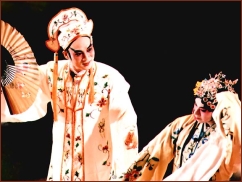 Around
1925, Taiwanese Opera entered the urban theater house and
became “Indoor-Stage Taiwanese Opera”. From Taipei to Tainan,
Taiwanese Opera troupes began to emerge. Plots and stage sets
were improved, artistic and music capacity was further enriched.
Female actors were allowed to act in Taiwanese Opera troupes.
Because female actors demonstrated their potential in delivering
the subtlety and delicacy of the script through their voice
and aesthetic movements, henceforward, the “weeping tune”
(kau diao)was produced. Scripts began to include more tragicomic
contents, which was appealing to a large amount of female
audience. Later, “Dou Ma Tune”(Do Ma Diao)was introduced to
Taiwanese Opera from Xiaman. Dou Ma Tune enriched the music
diversity of Taiwanese Opera. Since a vast amount of people
in Taiwan speak Taiwanese, Taiwanese Opera possesses extremely
powerful linguistic influence on Taiwan society. In addition,
inspiring plots, three-dimensional stage sets, and flexible
application of apparatus, these elements together had drawn
a tremendous attention and thus became popular among Taiwanese
people. Around
1925, Taiwanese Opera entered the urban theater house and
became “Indoor-Stage Taiwanese Opera”. From Taipei to Tainan,
Taiwanese Opera troupes began to emerge. Plots and stage sets
were improved, artistic and music capacity was further enriched.
Female actors were allowed to act in Taiwanese Opera troupes.
Because female actors demonstrated their potential in delivering
the subtlety and delicacy of the script through their voice
and aesthetic movements, henceforward, the “weeping tune”
(kau diao)was produced. Scripts began to include more tragicomic
contents, which was appealing to a large amount of female
audience. Later, “Dou Ma Tune”(Do Ma Diao)was introduced to
Taiwanese Opera from Xiaman. Dou Ma Tune enriched the music
diversity of Taiwanese Opera. Since a vast amount of people
in Taiwan speak Taiwanese, Taiwanese Opera possesses extremely
powerful linguistic influence on Taiwan society. In addition,
inspiring plots, three-dimensional stage sets, and flexible
application of apparatus, these elements together had drawn
a tremendous attention and thus became popular among Taiwanese
people.
|
 The Period of Japanese Occupation-Struggles
under the Assimilation Policy
The Period of Japanese Occupation-Struggles
under the Assimilation Policy |
After
the July Seventh Lugouqiao Incident in 1937, Japanese government
changed its governing attitude toward its colony, Taiwan.
Japanese government forced Taiwanese to learn to be Japanese,
to pledge loyalty to Japanese Emperor. Speaking Taiwanese
was strictly forbidden; therefore, Taiwanese Opera was banned.
The number of troupes sharply declined. The remaining troupes
struggled to survive by playing the drama in Japanese, wearing
kimonos instead of traditional Chinese outfit. This is called
the “ameliorated play”. In 1941, with the outbreak of the
Pacific War, Japanese government executed the “assimilation
policy”. Only officially approved theatric troupes were allowed
to perform, and to perform only in Japanese. All theater houses
were limited under allotment system. Because of such restriction,
Taiwanese Opera was strongly suppressed. |
 The Rise and Decline of Broadcasted and Televised
Taiwanese Opera
The Rise and Decline of Broadcasted and Televised
Taiwanese Opera |
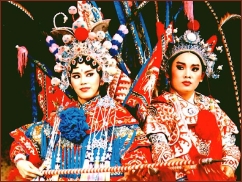 After
World War II was over, Taiwan was finally free from the rule
of Japanese government. Taiwanese Opera revived and took Taiwanese
people by storm. From 1949 to 1956, there were approximately
five hundred Taiwanese Opera troupes in Taiwan. Most of them
perform in theater houses, only a few of them perform on open-air
stages. During this period, temples hiring Taiwanese Opera
troupe to perform in recompense to God hadn’t become a fad,
while Taiwanese Opera hadn’t absorbed any elements from Luantan
shows, Taiwanese Opera was seldom played on open-air stages.
From 1954, American western movies and Japanese Samurai movies
were major box-office hit. Many theater houses were remodeled
into movie theaters. TV began to enter each household to dominate
each family’s entertainment; fewer and fewer people went
to theater houses to watch Indoor-Stage shows. Thus, in order
to survive, most of the Taiwanese Opera troupes transformed
into Outdoor-Stage performance and subordinated to temple
fairs. Since then, Indoor-Stage Taiwanese Opera was extinguished
from the society. After
World War II was over, Taiwan was finally free from the rule
of Japanese government. Taiwanese Opera revived and took Taiwanese
people by storm. From 1949 to 1956, there were approximately
five hundred Taiwanese Opera troupes in Taiwan. Most of them
perform in theater houses, only a few of them perform on open-air
stages. During this period, temples hiring Taiwanese Opera
troupe to perform in recompense to God hadn’t become a fad,
while Taiwanese Opera hadn’t absorbed any elements from Luantan
shows, Taiwanese Opera was seldom played on open-air stages.
From 1954, American western movies and Japanese Samurai movies
were major box-office hit. Many theater houses were remodeled
into movie theaters. TV began to enter each household to dominate
each family’s entertainment; fewer and fewer people went
to theater houses to watch Indoor-Stage shows. Thus, in order
to survive, most of the Taiwanese Opera troupes transformed
into Outdoor-Stage performance and subordinated to temple
fairs. Since then, Indoor-Stage Taiwanese Opera was extinguished
from the society.
The first Taiwanese Opera ever made into a movie was Shiue
Ping-guei & Wang Bau-chuan in 1955. From 1955 to 1959,
Taiwanese Opera movies were massively produced. It was the
golden era for Taiwanese Opera movies. At the same time, lots
of people also listened to Taiwanese Opera through radio broadcast,
especially in the 1960s. Not until televised Taiwanese Opera
emerged, did Taiwanese Opera radio broadcast and movies start
to decline.
|
 The Golden Era of Televised Taiwanese Opera
The Golden Era of Televised Taiwanese Opera |
In
October, 1962, TTV(Taiwan Television Enterprise)produced
and broadcasted the first televised Taiwanese Opera. This
initiated the era of televised Taiwanese Opera. In the beginning,
TV was not as popular as radio; therefore radio broadcasted
Taiwanese Opera remained a lot more popular than the televised
one. However, in 1966, TTV presented a new Taiwanese Opera
featuring the male lead enacted by Miss Yang Li-Hua. Her unique
charm, handsome stage appearance as well as her excellent
performance made her the most celebrated actress of Taiwanese
Opera. This is the first peak era of televised Taiwanese Opera.
Later, when CTV(China Television Company)and CTS(Chinese
Television System)were founded, they immediately produce
their own Taiwanese Opera programs. In 1972, TTV recruited
the current best leading actresses of Taiwanese Opera from
these three TV networks, such as, Yang Li-Hua, Yeh Ching,
Lin Mei-jau, Huang Shiang-lian. Together they made Xing Qi
Xia Wu Yi(Chivalry & Justice), which was extremely successful
and popular. The period from 1972 to 1977 was the golden era
of televised Taiwanese Opera. However, Government Information
Office set limits on Minan(Taiwanese)programs, the production
of televised Taiwanese Opera were diminished and for one year,
no Taiwanese Opera program could be seen on TV.
In 1979, TV stations began to produce Taiwanese
Opera programs. From then on, Taiwanese Opera programs went
through different stages of innovation. These days, different
kinds of media and channels offer viewers a variety of choices.
Televised Taiwanese Opera could no longer regain its overwhelming
popularity as it used to. From then on, Taiwanese Opera, again,
had to find a new way to survive. This time, Taiwanese Opera
develops into modern theater houses, displaying its new delicacy
and refinement.
|
 Developing
into Delicate Drama
Developing
into Delicate Drama |
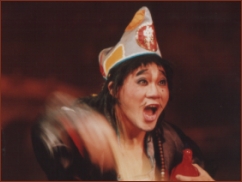 In
1973, the Cloud Gate Dance Theatre of Taiwan was founded.
The Cloud Gate infused the functioning system and technique
of western theater house into Taiwan’s theatric culture,
and thus changed Taiwanese people’s habit in watching art
performances. In 1979, a Peking Opera named Madame White Snake
was performed in Sun Yat-sen Memorial Hall, which was the
first traditional theatric form to perform on the stage of
national theater. In 1981, Miss Yang Li-hua was invited to
perform the play Yu Niang in the Sun Yat-sen Memorial Hall.
Followed by the Ming Hwa Yuan’s performance in Nationwide
Cultural and Arts Season. The Ming Hwa Yuan also enacted its
large drama Ji Gung Huo Fo(Living Buddha, The Lord Ji) on
the stage of Sun Yat-sen Memorial Hall. Taiwanese Opera demonstrated
its powerful delicacy in the following elements: the innovated
theme, well-knitted plot, spectacular stage sets, abundant
music accompaniment as well as the perfect performance of
all troupers. In
1973, the Cloud Gate Dance Theatre of Taiwan was founded.
The Cloud Gate infused the functioning system and technique
of western theater house into Taiwan’s theatric culture,
and thus changed Taiwanese people’s habit in watching art
performances. In 1979, a Peking Opera named Madame White Snake
was performed in Sun Yat-sen Memorial Hall, which was the
first traditional theatric form to perform on the stage of
national theater. In 1981, Miss Yang Li-hua was invited to
perform the play Yu Niang in the Sun Yat-sen Memorial Hall.
Followed by the Ming Hwa Yuan’s performance in Nationwide
Cultural and Arts Season. The Ming Hwa Yuan also enacted its
large drama Ji Gung Huo Fo(Living Buddha, The Lord Ji) on
the stage of Sun Yat-sen Memorial Hall. Taiwanese Opera demonstrated
its powerful delicacy in the following elements: the innovated
theme, well-knitted plot, spectacular stage sets, abundant
music accompaniment as well as the perfect performance of
all troupers.
|
|

